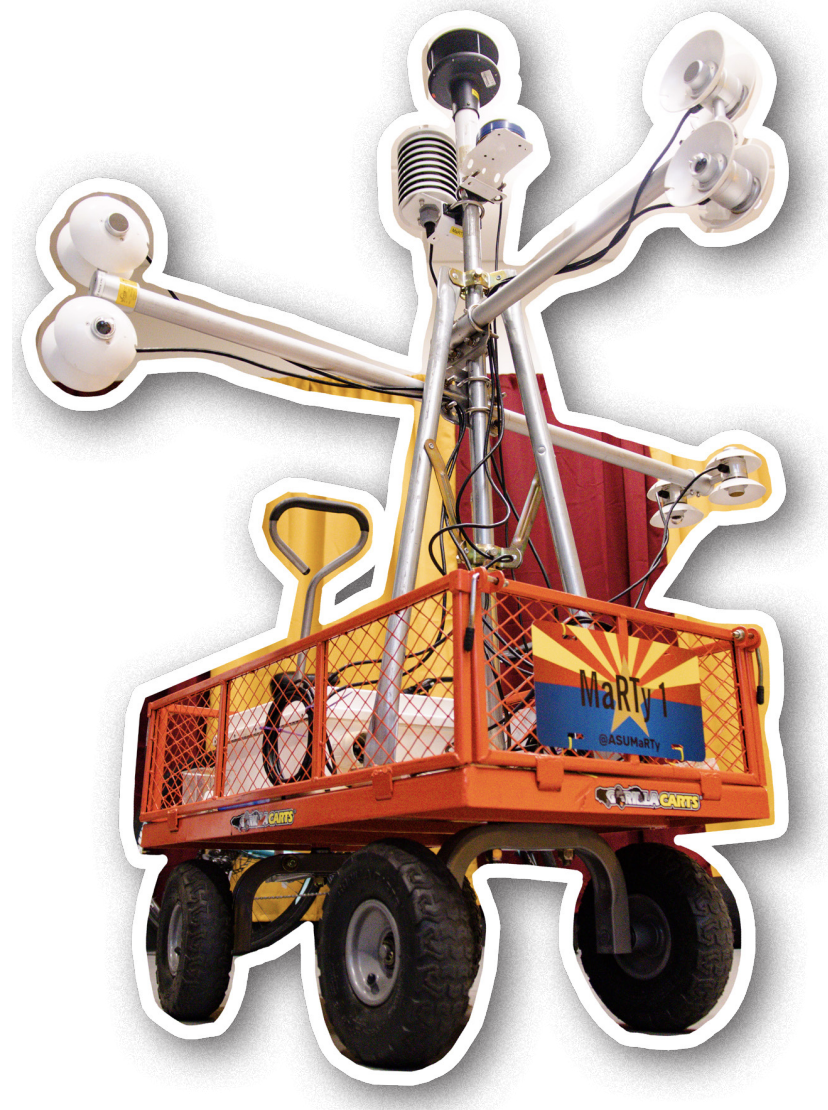
9 minute read
Hot, hotter, hottest
ASU’s role in mitigating Maricopa County’s urban heat islands
by Abigail Beck
Photos by Hajin Lee
Designs by Sydney Huyge
31.
That’s the longest stretch of days in history that Phoenix temperature highs held steady above 110 degrees, and it happened just this summer. 31 days of stubborn, still, unrelenting, record-breaking heat.
This was not unprecedented. Phoenix has seen an increase of 7.9 degrees in its July average temperature since the mid-1890s, according to The Washington Post. Since then, it’s only gotten hotter. Sept. 10 was the 54th day of a temperature high above 110 degrees in 2023, breaking a record last set in 2020.
For residents of the Valley, the only hope for reprieve is lukewarm pools and climate-killing air conditioning, and the only semblance of an oasis is the murky waters of Tempe Town Lake (ew).
Experts say this is partly because the Valley has an “urban heat island,” defined by the United States Environmental Protection Agency as “areas that experience higher temperatures than outlying areas.” These occur in cities where a surplus of buildings, roads and various infrastructure soak up the heat and spew it back into the city and its people via cars, air conditioning, industrial facilities and a lack of natural landscapes to cool the area.
Areas like downtown Phoenix and Tempe, where ASU’s two most populated campuses are housed, are prime examples of urban heat islands, as there is an abundance of hot asphalt, buildings and construction that aren’t environmentally friendly, said Grady Gammage Jr. Gammage is a land-use lawyer and the author of “The Future of the Suburban City: Lessons from Sustaining Phoenix.”
'There’s no question it’s hotter here than…certainly anywhere else where over a million people live.' – Chuck Redman
At the forefront of research on urban heat islands in Maricopa County are students, faculty and other members of the ASU community. Their research and the application of these observations have been a driving force behind managing the Valley’s ever-climbing historic heat, both within the University community and beyond.
To better understand the state’s intense heat, ASU scientists have formed research coalitions, such as the SHaDE Lab, and constructed robots and sensors to explore how heat affects the human body and how to best mitigate its impact.

How we got here
Chuck Redman has been at ASU for 40 years, long before the University’s trailblazing sustainability program was developed.
Redman helped found the School of Sustainability in 2006, the first school of sustainability in the world. Now, ASU is ranked first in sustainability practices nationwide and second globally among universities, according to the Sustainability Tracking, Assessment & Rating System.
According to Redman, much of the school’s early work on heat gained its footing on the Tempe campus.
“There’s no question it’s hotter here than…certainly anywhere else where over a million people live,” he said. “You know, for a large city, we’re the hottest and have gotten hotter. I mean, this year’s [a] demonstration that nature is not on our side on this.”
Since founding the school, Redman said he has felt a shift among community members in the Valley — their relationships with ASU heat scientists who have a unique understanding of the arid environment has blossomed.
What ASU has been doing
Konrad Rykaczewski, an associate professor at the School for Engineering of Matter, Transport and Energy, works closely with ASU’s ANDI — or Advanced Newton Dynamic Instrument — a humanoid heat robot that sweats, shivers, breathes and helps researchers better understand the effects extreme heat has on the human body without endangering real people.
While thermal manikins are used all over the world, ASU’s ANDI is the first that can function outside of a thermal chamber in a natural hot climate.
ANDI works primarily by changing its skin and core temperatures in response to intense heat and solar radiation. Researchers expose ANDI to different scenarios in a heat chamber called the “Warm Room,” which allows them to control factors like temperature, solar radiation and wind. This keeps researchers from having to resort to analyzing a real person in the hospital with heatstroke, for example, to gain insight into the effects of heat on the body, Rykaczewski said.
Different segments of the population experience heat differently based on traits like body size, preexisting medical conditions and age. Researchers account for this by designing and inputting different custom models into ANDI that allow it to simulate how a real person with those traits would react to a given heat scenario.
One of ANDI’s primary objectives during its first summer at ASU was to ensure it was compatible with MaRTy, a mobile instrument that “measures air temperature, humidity, wind speed and direction, and MRT (Mean Radiant Temperature),” according to the SHaDE Lab’s website.

“MaRTy can measure the heat load that the body experiences,” said Ariane Middel, the director of ASU’s SHaDE Lab, who works closely with both technologies. “It measures how the built environment impacts the heat signature of a certain location. But MaRTy cannot tell us what happens to the human body when you’re exposed to these conditions, and this is where ANDI comes in.”
ANDI has sweat glands that mimic those of a human so researchers can record how much a person would be sweating in a given environment and whether there would be any significant increases in their core temperature. MaRTy, on the other hand, records the amount of heat at a given location.

“MaRTy as a weather station setup existed way before I built him, but what people traditionally did with this type of weather station is they put it on a tripod, and then they set it up under a tree and let it log for a day,” Middel said. “I wanted to be able to compare different locations to each other…And so this is how the weather station [MaRTy] ended up being on a garden cart.”
While ASU is researching and developing new technologies to help scientists better understand and mitigate the urban heat island effect, researchers are also evaluating the efficacy of existing technologies.
Zachary Van Tol, a doctoral student studying sustainability and a SHaDE Lab team member who researches how extreme climates affect vulnerable communities, worked on a project that evaluated how well cool pavement reduces temperatures.
Cool pavement is a type of coating that maintains a lower surface temperature than regular pavement by reflecting sunlight. The purpose of cool pavement is to ensure that asphalt does not trap heat during the day, which in turn, could make sidewalks and roads cooler overnight.
To test if this coating was working throughout Phoenix, Van Tol designed a micrometeorological bike that “features fast response, high accuracy air temperature sensors at 4 heights and a surface temperature sensor,” according to the SHaDE Lab’s website.
In the project, “Cool Pavement Pilot Program,” the impact of the material on how people experienced heat was discovered to be less significant than expected, but the study is still ongoing.
Van Tol said a way to enhance cool pavement’s impact on how people experience heat is to apply it to a much larger portion of Phoenix’s asphalt than it currently is on. Otherwise, wind could blow heat from the uncovered asphalt to the areas that do have the coating.
The project discovered the surface temperature of streets with the reflective coating was 12 degrees cooler at noon and 10.5 degrees cooler during the afternoon hours than areas that lacked the coating.
“That’s really important, especially for areas that have been more disadvantaged historically — like south Phoenix, where there aren’t as many sidewalks [and] there’s not as much shade, so people are often walking over asphalt,” Van Tol said.
“There’s no such thing as one-size-fits-all mitigation. We have to be really cognizant of the spaces that we’re placing them in and what the sort of existing social infrastructure is.”
'Most of [the Valley's] landscaping requirements built into city codes have been about aesthetics — about what would look pretty. That's the wrong policy' – Grady Gammage Jr.
Where we go from here
Even though the Valley will always be hot, Gammage discussed policies that could be implemented to make this heat more livable, especially optimizing shade.
“Most of [the Valley’s] landscaping requirements built into city codes have been about aesthetics — about what would look pretty. That’s the wrong policy,” he said. “It should be about what provides shade, what provides comfort for people and what mitigates the heat effect.”
Gammage described some steps that could be taken to combat Phoenix’s intense heat, such as establishing a requirement about how much shade should be provided in the city.
ASU’s main Tempe campus is one of the most well-shaded areas of the city, partly because of tree and canopy cover. But when it comes to shade accessibility, a major region of concern for Gammage is the site of ASU’s second-largest campus: downtown Phoenix.
“Every time I’m in downtown Phoenix, I am struck by the fact that we could have built a downtown where all buildings had canopies that extended out over the street and shaded the sidewalk,” he said. “We have to think about how to make it more comfortable for people to get around in the heat.”
Outside of policy and city ordinances to prevent excessive heat exposure, another way to address extreme heat is behavior modification, which means altering the way we live to better adapt to metro Phoenix’s hot climate.
This includes using an umbrella or parasol to block the sun, wearing hats and heat-friendly clothes that have light colors, drinking plenty of water and avoiding being outside during the hottest parts of the day.
As fall steadily creeps closer and as the heat crawls its way toward the opposite hemisphere, Phoenix’s record-breaking temperatures will feel like a distant, dystopian dream.
But the national headlines will remember. The melted street signs will remember. The scalding asphalt will remember. And Phoenix must remember.







